Visions of Chagall: Seeing a new world
3 March 2015
Russian-born artist Marc Chagall lived through many of the traumas of the twentieth century. The experience of two European wars and Tsarist, Communist and Nazi persecution didn't dent Chagall's creativity or human spirit. WILLIAM COOK visits a major retrospective celebrating the artist's long career through an exhibition of over 200 of his works at Brussel's Royal Museums of Fine Arts.

‘One grows into the works,’ says Meret Meyer, as we stand before her grandfather’s paintings, marvelling at the figures that seem to dance and shimmer on the wall. ‘Everywhere there are metaphors.’ But above all, there is beauty.
A Russian Jew, Marc Chagall survived Tsarist pogroms, Soviet communism and the Nazi Holocaust. His long life was a mirror of the last century.
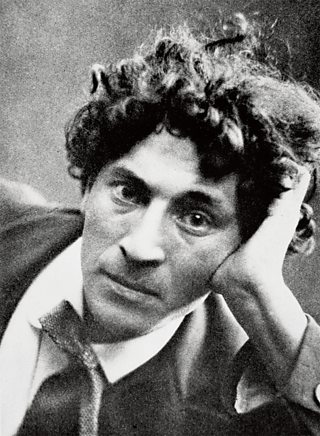
I do not want to be like all the others, I want to see a new worldMarc Chagall
Yet though his pictures are etched with grief, their overriding emotion is joy. ‘I do not want to be like all the others,’ declared Chagall. ‘I want to see a new world.’ He created a new world in his paintings. Thirty years since his death, his joie de vivre still shines through.
This big new retrospective of Chagall’s work attracted 340,000 visitors during its first run in Milan over Christmas. For the next four months it’s in Brussels, at the Musées Royaux des Beaux Arts. It covers the full sweep of Chagall’s career, from his poignant early paintings of village life to his florid designs for the Metropolitan Opera in New York, more than half a century later.
‘It’s a summary of the whole life,’ says Meyer, ‘of someone who passed through all these tragedies.’ She was thirty when her grandfather died, so she got to know him fairly well. ‘He was not a verbal man,’ she says. His main means of communication was his art.
There are over 200 works on show, from theatre sets and ballet costumes to illustrations from his autobiography. However it’s his paintings, awash with colour, which really arrest the eye. Some of the juxtapositions are sublime.
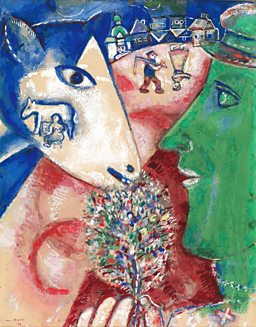
Birthday, on loan from the Museum of Modern Art in New York, shows Chagall kissing his first wife, Bella, floating on a cloud of happiness. The Poet Reclining, loaned by Tate Britain, was painted on their honeymoon, in the same year. Seeing them side by side is like listening to both sides of the same LP.
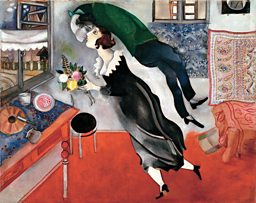
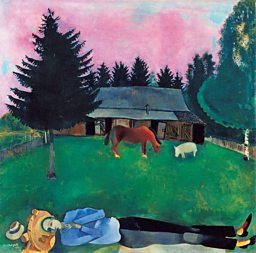
Chagall never lost his love of life, in spite of all the pain he saw.
His Jewish roots were important, but above all he was an artist for all mankind
The Fall of The Angel is a haunting allegory for the horrors of the Holocaust. In the corner of the canvas is Christ on the Cross, a sign that he saw the Shoah as a universal human tragedy, not just a Jewish one.
Chagall’s humanity was what made him a great artist, rather than just a proficient painter of pretty pictures. His Prodigal Son is full of tenderness. His Jewish roots were important, but above all he was an artist for all mankind.
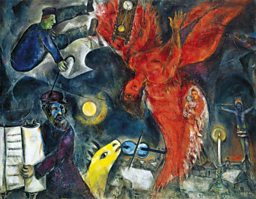
Like all truly talented artists, he also had a sense of humour. When a Berlin gallery mistakenly hung one of his paintings upside down, Chagall decided he preferred it that way, and insisted on hanging it that way in future.
You can see it hanging here, still the wrong way round. I tried to look at it the right way up and almost cricked my neck. Appropriately, it’s called Man With His Head Thrown Back.

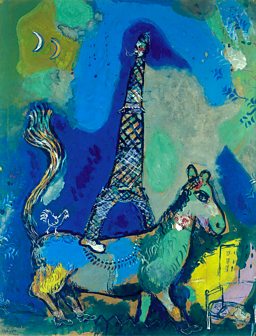
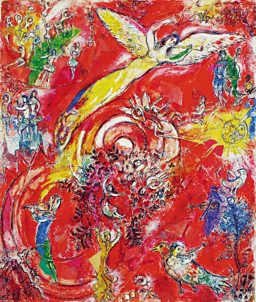

Born in 1887 in Vitebsk (now in Belarus), Chagall studied art in St Petersburg and moved to Paris in 1911. In 1914, he returned to Russia for a brief visit, but was marooned there by the First World War and the Russian Revolution. He finally returned to France in 1922.
His lighter postwar work has its own unique qualities – restraint, gentleness, humility
In 1937, the Nazis denounced his work as ‘degenerate.’ In 1941 he fled to the USA, but returned to France in 1948, where he lived until his death in 1985, at the grand old age of 97.
Had Chagall died in 1948, he’d probably be regarded as a daring avant-gardist. Inevitably, his later work wasn’t quite so cutting edge. His most powerful pictures are of his old hometown, Vitebsk: ‘the moon over the forest, the pig in the barn, the horse in the meadow, the lilac sky.’ Yet his lighter postwar work has its own unique qualities – restraint, gentleness, humility.
This exhibition proves that his mature paintings were just as good. And anyway, who cares if his final works weren’t groundbreaking? They’re just as beautiful and life affirming as the artworks of his youth.
If anyone deserved to spend his old age painting pleasant still lives, it was Marc Chagall. Six million of his fellow Jews had been murdered by ‘the sons of Durer, Cranach and Holbein.’ His beloved Bella had died.
When I found myself in Nice, where I had never been before, I felt like I had arrived in the kingdom of flowersMarc Chagall
He made his new home on the Cote d’Azur, where his art found a new direction. ‘When I found myself in Nice, where I had never been before, I felt like I had arrived in the kingdom of flowers.’ For the next four decades, his happy, hopeful paintings were strewn with flowers, like a garden in full bloom.
‘Chagall is not only one of the major artists of the 20th Century,’ says Michel Draguet, the director of this museum. ‘He’s also a kind of philosopher.’
He’s quite right. It’s Chagall’s compassion in the face of suffering that makes him an artist for our troubled times. ‘Chagall finds in painting a way to rebuild the world.’
Marc Chagall: A Retrospective is at the Royal Museums of Fine Arts of Belgium, Brussels until 28 June, 2015.

Related Links


Art and Artists: Highlights
-
![]()
Ai Weiwei at the RA
The refugee artist with worldwide status comes to London's Royal Academy
-
![]()
BBC Four Goes Pop!
A week-long celebration of Pop Art across BBC Four, radio and online
-
![]()
Bernat Klein and Kwang Young Chun
Edinburgh’s Dovecot Gallery is hosting two major exhibitions as part of the 2015 Edinburgh Art Festival
-
![]()
Shooting stars: Lost photographs of Audrey Hepburn
An astounding photographic collection by 'Speedy George' Douglas
-
![]()
Meccano for grown-ups: Anthony Caro in Yorkshire
A sculptural mystery tour which takes in several of Britain’s finest galleries
-
![]()
The mysterious world of MC Escher
Just who was the man behind some of the most memorable artworks of the last century?
-
![]()
Crisis, conflict... and coffee
The extraordinary work of award-winning American photojournalist Steve McCurry
-
![]()
Barbara Hepworth: A landscape of her own
A major Tate retrospective of the British sculptor, and the dedicated museums in Yorkshire and Cornwall
Art and Artists
-
![]()
Homepage
The latest art and artist features, news stories, events and more from BBC Arts
-
![]()
A-Z of features
From Ackroyd and Blake to Warhol and Watt. Explore our Art and Artists features.
-
![]()
Video collection
From old Masters to modern art. Find clips of the important artists and their work











